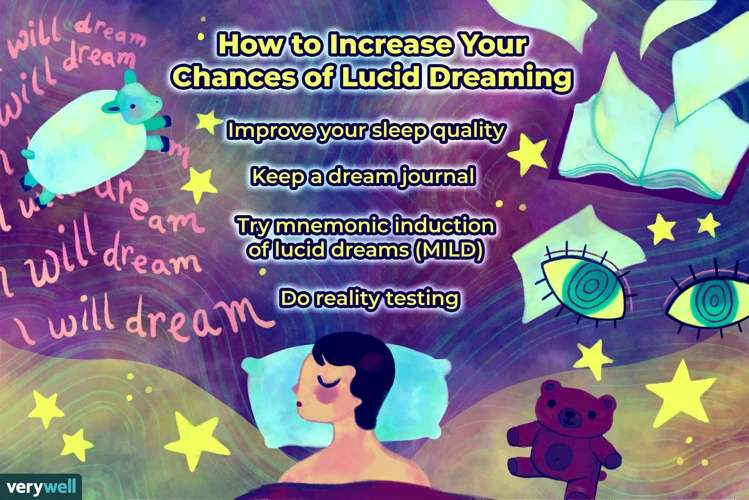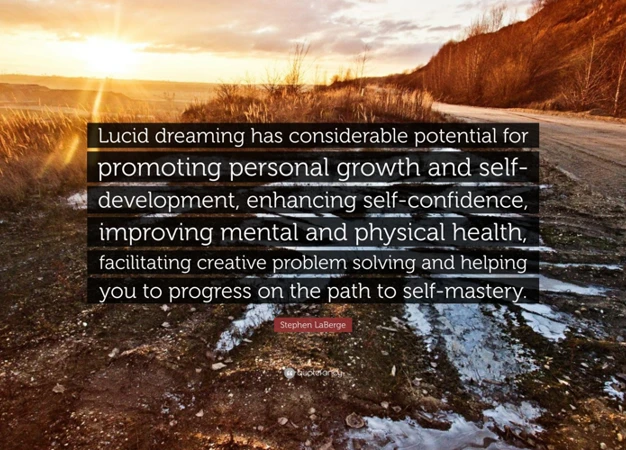What is Lucid Dreaming?

Lucid dreaming is a state of consciousness where the dreamer becomes aware that they are dreaming while still within the dream itself. This awareness gives the dreamer the ability to consciously control and manipulate their dream environment, as well as their own actions and experiences. While the concept of lucid dreaming may seem fantastical, it has been scientifically validated and studied extensively. When lucid, the dreamer is able to actively participate in the dream world, making decisions, interacting with dream characters, and even shaping the dream narrative. Lucid dreaming is a vivid and immersive experience, often indistinguishable from waking reality, and can provide a profound sense of empowerment and self-discovery.
Definition and Explanation
How to Achieve Lucid Dreaming
Benefits of Lucid Dreaming
The Link Between Lucid Dreaming and Personal Transformation

Lucid dreaming and personal transformation are intimately connected. Lucid dreaming provides a unique opportunity for self-discovery and exploration. By becoming aware within the dream state, individuals can delve into their subconscious mind, uncovering hidden desires, fears, and unresolved emotions. This self-awareness can lead to a deeper understanding of oneself and facilitate personal growth.
Lucid dreaming allows individuals to confront and overcome their fears and limitations. In the lucid dream state, individuals can deliberately face challenging scenarios, confront their fears head-on, and practice overcoming obstacles. This can have a profound impact on their waking lives, as the confidence and resilience gained in lucid dreams can transfer to real-life situations.
Lucid dreaming also has the potential to enhance creativity and problem-solving abilities. The dream world is a playground of infinite possibilities, where the laws of physics and limitations of the waking world do not apply. This freedom allows for unbridled creativity and the exploration of innovative ideas. Lucid dreaming can be used as a tool for problem-solving and brainstorming, as individuals can actively engage with their dreams and seek solutions to real-world challenges.
The link between lucid dreaming and personal transformation is undeniable. Whether it be through self-discovery, overcoming fears, or enhancing creativity, lucid dreaming opens the door to a realm of limitless potential for growth and transformation.
Self-Discovery and Exploration
Self-discovery and exploration are core elements of personal transformation, and lucid dreaming provides a unique platform for these experiences. Within the lucid dream state, individuals have the opportunity to delve deep into their subconscious mind, uncovering hidden desires, fears, and aspirations. Through self-reflection and introspection, lucid dreamers can gain valuable insights into their true selves and their personal growth journey. They can confront and overcome their fears, work through challenging emotions, and even engage in self-healing. Lucid dreaming allows for the exploration of uncharted territories within the mind, unlocking the potential for profound self-discovery and personal transformation. Whether it’s venturing into unexplored dreamscapes or engaging in deep conversations with dream characters, lucid dreaming opens the door to a world of exploration and self-understanding.
Consider reading our article on lucid dreaming for spiritual growth to explore how this practice can connect with your spiritual journey.
Overcoming Fears and Limitations
One of the most powerful ways in which lucid dreaming can contribute to personal transformation is by providing a platform for overcoming fears and limitations. In the realm of lucid dreams, individuals have the opportunity to confront and conquer their deepest fears in a safe and controlled environment. Whether it’s a fear of heights, public speaking, or spiders, lucid dreaming allows individuals to face these fears head-on, knowing that they are in a dream and can control the outcome. By repeatedly facing and overcoming these fears in their lucid dreams, individuals can gradually diminish the impact of these fears in their waking life as well. It’s a process of desensitization and empowerment, where individuals develop the confidence and resilience to confront and overcome their limitations. With practice, lucid dreaming can become a valuable tool for personal growth and self-transformation.
Enhancing Creativity and Problem-Solving Abilities
One of the remarkable benefits of lucid dreaming is its potential to enhance creativity and problem-solving abilities. When we are in a lucid dream, our minds have access to a vast realm of imagination and unlimited possibilities. We can explore new ideas, experiment with different scenarios, and push the boundaries of our creativity. Lucid dreaming allows us to tap into our subconscious mind, where innovative solutions and insights may arise. Through lucid dreaming, we can engage in creative activities such as painting, composing music, or writing stories, which can manifest in our waking life. Additionally, lucid dreaming can serve as a powerful tool for problem-solving. We can consciously confront and work through challenges or dilemmas within the safety of the dream world. By entering a lucid dream with a specific problem in mind, we can explore different perspectives, test out potential solutions, and gain valuable insights that can be translated into real-life situations. Lucid dreaming has been recognized as a valuable tool for enhancing creativity and problem-solving, and by utilizing this unique state of consciousness, we can unlock hidden potentials and achieve breakthroughs in our waking lives.
Techniques to Maximize Personal Transformation in Lucid Dreams

Reality Testing and Reality Checks
Developing Dream Control and Awareness
Developing dream control and awareness is a crucial aspect of maximizing the potential for personal transformation in lucid dreams. To enhance dream control, it is essential to practice various techniques and exercises regularly. One effective technique is reality testing, which involves checking if you are dreaming multiple times throughout the day. This habit will carry over into your dreams, increasing the likelihood of becoming lucid. Another technique is known as “reality checks,” where you question the state of reality during both waking and dreaming moments. By incorporating these reality checks into your daily routine, you will enhance your capacity to recognize when you are dreaming, thus increasing your level of dream control. Additionally, maintaining a dream journal is highly beneficial for developing dream awareness. Recording your dreams immediately upon waking helps to improve dream recall and fosters a deeper connection to your dream experiences. With enhanced dream control and awareness, you can actively shape your dreams, explore different scenarios, and work towards personal transformation while in the lucid dreaming state.
Intention Setting and Visualization
- Intention Setting: One powerful technique for maximizing personal transformation in lucid dreams is through intention setting. Before going to bed, set a clear and specific intention for what you want to achieve or experience in your lucid dream. It could be anything from facing a fear, gaining insight into a problem, or exploring a particular aspect of your personality. By setting an intention, you are sending a signal to your subconscious mind, priming it to focus on that specific goal during your dream. This can help guide the direction of your lucid dream and bring about meaningful transformation.
- Visualization: Another effective technique is visualization. This involves vividly imagining and mentally rehearsing your desired scenario or outcome while in a lucid dream. Visualize yourself already transformed in the way you desire, experiencing the personal growth you seek. Engage all your senses and truly immerse yourself in the experience. For example, if your intention is to become more confident, visualize yourself in a situation where you exude confidence, feel the emotions associated with it, and see how it positively affects your interactions and outcomes. The power of visualization lies in its ability to reprogram your subconscious mind and align your thoughts, beliefs, and actions with your desired transformation.
Combining Lucid Dreaming with Other Transformational Practices
Meditation and Mindfulness
Meditation and mindfulness practices complement lucid dreaming beautifully, enhancing the potential for personal transformation. Both meditation and lucid dreaming involve cultivating a state of heightened awareness and presence in the moment. By incorporating meditation into your daily routine, you can develop a deeper level of mindfulness, which will naturally carry over into your dreams. This increased mindfulness can make it easier to recognize when you are dreaming and become lucid within the dream. Similarly, lucid dreaming can also serve as a form of meditation, allowing you to explore the depths of your consciousness and cultivate a sense of calm and clarity. By combining meditation and lucid dreaming, you can harness the power of both practices to deepen your self-awareness, promote relaxation, and uncover profound insights about yourself and the world around you.
Affirmations and Positive Thinking
Affirmations and positive thinking are powerful tools that can greatly enhance the transformative potential of lucid dreaming. By incorporating positive affirmations into your lucid dreams, you can actively program your subconscious mind and shape your beliefs and perceptions. During a lucid dream, you can repeat positive affirmations such as “I am confident and capable,” or “I am worthy of happiness and success.” By doing so, you are reinforcing these positive beliefs and embedding them into your subconscious mind.
Additionally, positive thinking plays a crucial role in shaping the outcomes and experiences within lucid dreams. Maintaining a positive mindset during a lucid dream can help to overcome obstacles, fears, and limitations. When faced with a challenging situation or a fear-inducing scenario in a lucid dream, practicing positive thinking can empower you to find creative solutions, face your fears head-on, and transform negative experiences into positive ones.
It is important to note that affirmations and positive thinking are not limited to the dream state alone. By incorporating these practices into your waking life, you can amplify their effects within your lucid dreams. Regularly affirming positive beliefs and maintaining an optimistic mindset during your waking hours can reinforce these patterns in your dream state as well.
Utilizing affirmations and positive thinking in conjunction with lucid dreaming can create a powerful synergy for personal transformation. It allows you to actively shape your mindset, beliefs, and experiences both in the dream world and in your everyday life. By aligning your thoughts, intentions, and actions, you can unlock your full potential for growth, self-realization, and personal transformation.
Journaling and Self-reflection
In addition to recording your dreams, engaging in self-reflection while awake can also amplify the transformative effects of lucid dreaming. Taking the time to reflect on your thoughts, emotions, and experiences from both waking life and the dream state can lead to greater self-awareness and personal growth. Self-reflection allows you to explore the connections between your dreams and your waking life, uncovering hidden meanings and messages that may have eluded you. It can be helpful to ask yourself thought-provoking questions, such as, “What emotions did I experience in my dream?”, “What themes or symbols stood out?”, or “How do these dream experiences relate to my current life circumstances?”. By engaging in regular journaling and self-reflection, you can deepen your understanding of yourself and harness the transformative power of lucid dreaming to its fullest extent.
Conclusion
Frequently Asked Questions
What is the difference between a regular dream and a lucid dream?
A regular dream is a series of unconscious thoughts and images that occur during sleep, while a lucid dream is when the dreamer becomes aware that they are dreaming and can actively control and manipulate the dream.
Is lucid dreaming a natural phenomenon?
Yes, lucid dreaming is a natural phenomenon that occurs during REM (rapid eye movement) sleep, which is the stage of sleep where most dreaming occurs.
Can anyone learn to lucid dream?
Yes, with practice and consistent effort, most people can learn to lucid dream. It may take time and patience to develop the necessary skills and awareness, but it is achievable for many individuals.
Does lucid dreaming have any benefits?
Absolutely, lucid dreaming has many potential benefits. It can be used for personal growth, self-development, enhancing creativity, problem-solving, and even overcoming fears and limitations.
How can I start having lucid dreams?
There are various techniques that can help you start having lucid dreams. Some popular methods include reality testing, dream journaling, and practicing visualization and intention setting before sleep.
Can lucid dreaming be dangerous?
Lucid dreaming is generally considered safe for most individuals. However, it’s important to approach it responsibly and with a clear understanding of your own mental and emotional well-being. If you have a history of mental health issues, it may be wise to consult with a healthcare professional before engaging in lucid dreaming practices.
Can lucid dreaming be used for problem-solving and creativity?
Absolutely, lucid dreaming can be a powerful tool for problem-solving and enhancing creativity. By consciously exploring dream scenarios and manipulating dream elements, you can tap into your subconscious mind and unlock innovative solutions and ideas.
Is there a connection between lucid dreaming and spiritual growth?
Some people believe that lucid dreaming can enhance spiritual growth and inner exploration. It offers a unique opportunity to connect with deeper aspects of oneself and explore the realms of consciousness beyond the physical reality.
Can lucid dreaming be used to overcome fears and limitations?
Yes, lucid dreaming can be a valuable tool for overcoming fears and limitations. By confronting and working through fears in the safe space of a lucid dream, individuals can build confidence and develop strategies for overcoming challenges in their waking lives.
Are there any resources available for further exploration of lucid dreaming?
Yes, there are many resources available, including books, online forums and communities, lucid dreaming apps, and guided meditation programs. These resources can provide guidance, tips, and techniques to further enhance your lucid dreaming practice.








